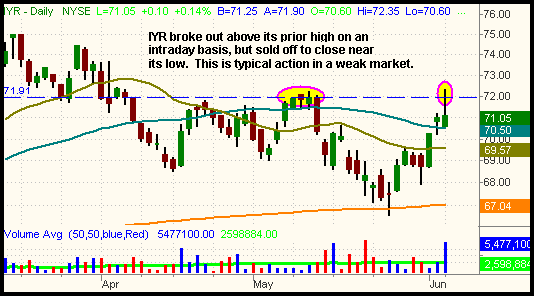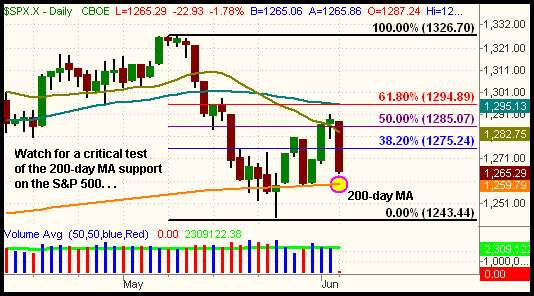The broad market suffered heavy losses yesterday, causing the major indices to fall back down to near their May lows. The small-cap Russell 2000 plummeted 3.2% and the 2.2% loss in the Nasdaq Composite was not much better. Both the S&P 500 and Dow Jones Industrial Average shed 1.8%, as the S&P Midcap 400 slid 2.4%. Although stocks gapped open slightly lower yesterday, most of the losses resulted from steady intraday downtrends in the major indices, each of which finished at their worst levels of the day. As we discussed, the "churning" that occurred in the first hour of last Friday's session foreshadowed yesterday's bearish action and resumption of the broad market's four-week downtrend.
Volume levels started out lower yesterday, but turnover picked up dramatically as the selling intensified in the afternoon. As of 1:30 pm, when the S&P 500 was down only 0.6%, total volume in the NYSE was on pace to be 22% lighter than the previous day's level. However, trading activity surged higher as the broad market selloff picked up momentum in the afternoon. By day's end, volume in the NYSE had exceeded the previous day's level by 3%. The losses on higher volume were indicative of institutional selling and caused a bearish "distribution day" to register on the S&P. In the Nasdaq, turnover also increased in the late afternoon, but that exchange still saw a 7% drop in total volume. Market internals were just plain ugly. Declining volume in the NYSE pounded advancing volume by a whopping margin of more than 10 to 1! Do any of you ever recall seeing a worse ratio? We don't. The Nasdaq's declining/advancing volume ratio was negative by 7 to 1.
As the extremely bearish market internals confirmed, yesterday's selling was quite broad-based, leaving no major pockets of sector strength in which to hide. One sector that did manage to close higher was the Dow Jones Real Estate Index ($DJUSRE), but only by 0.3%. In the morning, it looked as the Real Estate ETFs were going to break out, but they fell victim to broad market weakness in the afternoon and closed below their breakout levels. The two major ETFs that track the Real Estate markets are the iShares DJ Real Estate Index Trust (IYR) and the iShares Cohen and Steers Realty Majors (ICF). Looking at the daily chart below, notice how IYR rallied above its prior highs on an intraday basis, but finished near the bottom of its range:

We pointed out the Real Estate ETFs because that sector showed the most relative strength to the broad market yesterday, but we also wanted to convey just how difficult it is to be long in the current market environment. Even when you pick the right sector, a difficult enough task in itself, the selling pressure from the broad market is probably going to prevent the sector from rallying in any significant manner. This is why we simply follow the primary trend of the broad market rather than fighting it. Just as water flowing down a stream will always follow the path of least resistance, so too will the stock market. If there is more supply than demand, stock prices will move lower, regardless of how much it may have already fallen. Therefore, we hope you have been following our advice to avoid the long side of the market or, at the very least, have been trading with reduced share size and only on a very short term basis to play counter-trend bounces. If you're net short right now, the market is giving you a lot of room for error with choosing the proper sectors and even the proper timing. This is why it is always easier to profit from a stock market that is trending steadily in either direction; you can make a few mistakes and often still come out on top just as long as you are on the right side of the market.
Taking an updated look at the S&P 500, the most notable technical event is that the index failed to retrace more than 50% of its loss from the May high down to the May low. We have illustrated this with Fibonacci retracement lines on the daily chart below:

When an index reverses sharply after retracing less than 61.8% of its last move, odds are good that the direction of the primary trend will resume. In this case, that means we are likely to see a test of the May 24 low within the next week or so. But more important is support of the 200-day moving average. It acted as support that triggered a broad market bounce last month, but a subsequent close below the 200-day MA would be rather bearish and could trigger heavy institutional selling. Because of these factors, we like the risk/reward of selling short the S&P 500 SPDR (SPY). In hindsight, the most ideal entry point would have been yesterday, but it would have also been a riskier entry point before getting confirmation that the retracement in the S&P was finished. Showing even more relative weakness than the S&P 500 is the Dow Jones Industrial Average, which reversed yesterday after failing to penetrate resistance of both its 20 and 50-day moving averages. DIA finished only 0.3% above its closing low from May, so we now expect that prior low to be broken over the next few days as well. If DIA slides below last month's low, expect it to quickly fall down to its 200-day moving average, which is presently at 108.65 (10,867 on the Dow Jones).
Deron Wagner is the Founder and Head Trader of both Morpheus Capital LP, a U.S. hedge fund, and Morpheus Trading Group, a trader education firm launched in 2001 that provides daily technical analysis of the leading ETFs and stocks. For a free trial to the full version of The Wagner Daily or to learn about Wagner's other services, visit MorpheusTrading.com or send an e-mail to deron@morpheustrading.com.